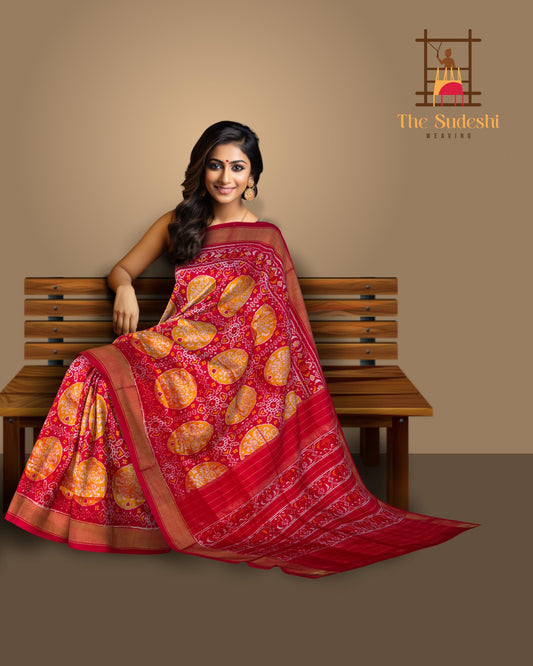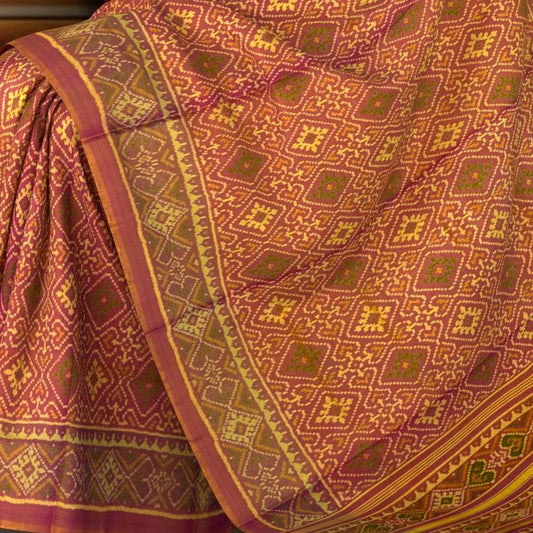The Influence of Patola Motifs on Contemporary Art: Tradition Meets Modernity
In the ever-evolving world of contemporary art, where innovation and tradition often merge, Patola motifs have emerged as a vibrant source of inspiration. Rooted in the rich textile heritage of Gujarat, India, Patola designs are celebrated for their intricate patterns, vibrant colors, and deep cultural significance. As modern artists seek to bridge the gap between the past and the present, Patola motifs have found a new life on the canvas, influencing a generation of creators who are drawn to their timeless beauty and symbolism.
This blog delves into the fascinating journey of Patola motifs from traditional textiles to contemporary art. We will explore how these patterns have inspired modern artists, examine notable works that incorporate Patola designs, and highlight exhibitions that showcase the enduring allure of Patola in the world of art.
The Rich Legacy of Patola Motifs
Patola, a traditional form of double ikat weaving, has been an integral part of Gujarat's cultural heritage for centuries. Originating from the town of Patan, these textiles are renowned for their complex patterns, painstakingly woven using a resist dyeing technique that involves the meticulous alignment of warp and weft threads. The result is a fabric that boasts intricate, mirror-image designs, often featuring motifs such as elephants, parrots, dancing figures, and floral patterns.
Historically, Patola saris were worn by the aristocracy and were considered symbols of wealth and status. The motifs themselves are steeped in cultural and religious symbolism, representing auspiciousness, fertility, and protection. Over time, these patterns have transcended their original context, capturing the imagination of artists and designers across various disciplines.
Patola Motifs in Modern Art: A Creative Fusion
In the realm of contemporary art, where the boundaries between tradition and modernity are constantly being redefined, Patola motifs have emerged as a powerful source of inspiration. Artists are drawn to the geometric precision, vibrant color palettes, and the cultural depth of Patola designs, which they reinterpret in innovative ways.
1. Abstraction Meets Tradition
One of the most compelling aspects of Patola motifs is their geometric complexity, which lends itself beautifully to abstraction—a hallmark of modern art. Artists have taken the intricate patterns of Patola and transformed them into abstract compositions that explore themes of identity, memory, and cultural continuity. These works often juxtapose the traditional symmetry of Patola with more fluid, contemporary forms, creating a dialogue between the old and the new.
2. Patola in Mixed Media and Installations
Beyond paintings, Patola motifs have found expression in mixed media art and installations. By incorporating traditional textile fragments into their work or recreating the patterns using unconventional materials, artists pay homage to the craftsmanship of Patola weaving while pushing the boundaries of artistic expression. These pieces not only highlight the visual appeal of Patola designs but also evoke a sense of cultural nostalgia and reverence.
3. Reviving Craftsmanship Through Art
For some artists, the use of Patola motifs goes beyond aesthetic appreciation; it is a conscious effort to revive and preserve traditional craftsmanship. By incorporating these designs into contemporary artworks, they draw attention to the intricate skill and labor involved in creating Patola textiles, which are increasingly under threat from industrialization and changing consumer preferences. Through their work, these artists advocate for the preservation of cultural heritage and sustainable practices in art and design.
Artists Inspired by Patola Designs
The influence of Patola motifs on contemporary art can be seen in the works of several prominent artists who have seamlessly integrated these traditional patterns into their creative vocabulary. Here are a few notable examples:
1. Manisha Parekh
Manisha Parekh, an acclaimed contemporary artist, has explored the intersection of traditional Indian art forms and modern abstraction in her work. Her use of Patola motifs is a recurring theme, where she deconstructs the patterns and reinterprets them through intricate drawings, collages, and mixed media compositions. Parekh's work reflects a deep engagement with the cultural and symbolic significance of Patola, while also challenging the viewer's perception of tradition in a modern context.
2. Gulammohammed Sheikh
Gulammohammed Sheikh, a pioneering figure in Indian contemporary art, has long been fascinated by the visual language of traditional Indian textiles, including Patola. His paintings often feature Patola-inspired motifs, woven into complex narratives that blend mythological themes with contemporary concerns. Sheikh's work exemplifies how traditional patterns can be recontextualized to comment on broader social and political issues, while still retaining their cultural resonance.
3. Hema Upadhyay
The late Hema Upadhyay was known for her large-scale installations and sculptural works that explored themes of urbanization, migration, and identity. In several of her pieces, Upadhyay incorporated Patola motifs as a means of connecting personal and collective histories. By juxtaposing these traditional designs with modern urban landscapes, she highlighted the tensions between tradition and modernity, and the impact of globalization on cultural heritage.
Exhibitions Showcasing Patola-Inspired Art
The growing interest in Patola motifs within the contemporary art scene has led to several exhibitions dedicated to showcasing Patola-inspired art. These exhibitions not only celebrate the aesthetic beauty of Patola designs but also explore their cultural significance and relevance in today's world.
1. "Threads of Continuity: Patola Motifs in Modern Art"
This exhibition, held at a leading contemporary art gallery, brought together a diverse group of artists who have been inspired by Patola motifs. The exhibition featured paintings, mixed media works, and installations that reinterpreted the traditional designs in new and innovative ways. Each piece on display offered a unique perspective on the intersection of tradition and modernity, highlighting the enduring appeal of Patola motifs in contemporary art.
2. "Weaving the Past: Patola and Beyond"
"Weaving the Past" was an immersive exhibition that explored the cultural history of Patola textiles and their influence on contemporary art and design. The exhibition included traditional Patola saris, alongside modern artworks that drew inspiration from their intricate patterns. Through a combination of visual art, video installations, and interactive displays, the exhibition offered visitors a deeper understanding of the craftsmanship behind Patola and its continued relevance in the art world.
3. "Contemporary Reflections: Patola in the 21st Century"
This exhibition focused on the ways in which contemporary artists have reimagined Patola motifs in their work. Featuring a mix of established and emerging artists, the exhibition showcased a wide range of mediums, from paintings and sculptures to textiles and digital art. The curatorial approach emphasized the versatility of Patola designs and their ability to transcend cultural and temporal boundaries, resonating with artists and audiences alike.
Conclusion
The revival of Patola motifs in contemporary art is a testament to the enduring power of traditional designs and their ability to inspire new creative expressions. As artists continue to explore the rich visual language of Patola, they not only preserve a vital aspect of cultural heritage but also infuse it with new life, ensuring its relevance for future generations. Through their work, these artists invite us to appreciate the intricate beauty of Patola motifs and to reflect on the deeper connections between tradition and modernity.
In a world where the past and present often collide, Patola motifs serve as a bridge, connecting us to our cultural roots while inspiring us to imagine new possibilities in art. Whether through abstract compositions, mixed media, or large-scale installations, the influence of Patola designs in contemporary art is a powerful reminder of the timeless appeal of traditional craftsmanship in the modern age.







Leave a comment
Please note, comments need to be approved before they are published.